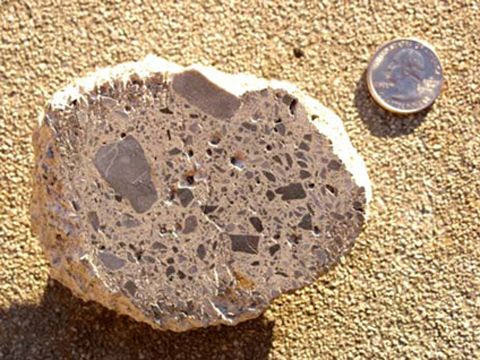When geologists wanted to test drilling equipment for an Apollo mission in the 1960s, they used a crater in Tennessee. Fifty years later, those samples are providing Dr. Keith Milam a look back into a ancient time when meteorites pummeled the Earth.
“Back when Wisconsin and western Russia once shared an address south of the equator, a violent collision in the asteroid belt blasted Earth with meteorites,” writes Becky Oskin in a Live Science story on “Crater Hunters Find New Clues to Ancient Impact Storm.”
“The space rock smashup showered Earth with up to 100 times more meteorites than today’s rate (a rock the size of a football field hits the planet about every 10,000 years). Yet, only a dozen or so impact craters have been found from the ancient bombardment 470 million years ago, during the Ordovician Period. Most are in North America, Sweden and western Russia. There are only about 185 known impact craters on Earth of any age, while the moon has more than 100,000,” she writes.
“But the number of Ordovician craters may soon take off. That’s because it’s easier and cheaper than ever to hunt down evidence that confirms an impact. The clinchers include shocked minerals, deformed rocks and structural features that match other craters.”
Among the discoveries that Oskin writes about is Milam’s work in the Howell Structure in Tennessee. “The bowl-shaped basin is about the same diameter as Brussels Hill (about 1.2 miles, or 2 km). In this case, however, the suspected crater is weaker than the surrounding rocks, creating a depression. A pile of fragmented carbonate and other craterlike features suggests an impact origin.
Benefiting from Space Program Research
“Keith Milam, a professor at Ohio University in Athens, recently uncovered a rare trove of rock cores drilled at Howell in the 1960s. John Bensko, a retired lunar geologist from NASA’s Marshall Space Flight Center, provided the 15 segments. Bensko oversaw the testing of drilling equipment intended for the canceled Apollo 18 program. The first tests on the rock cores suggest the fragmented carbonate rocks were shocked by a meteorite impact, Milam reported at the Vancouver meeting,” writes Oskin.
Milan presented “An Assessment of Shock Metamorphism in Breccias from the Howell Structure, Lincoln County, Tennessee, USA” at the Geological Society of American annual meeting in October in Vancouver. Milam is Associate Professor of Geological Sciences at Ohio University. His co-authors were Tim Henderson of Ohio University and Bill Deane of the University of Tennessee.
“The Howell Structure is an anomalous circular area (~2.5 km diameter) of brecciated Middle Ordovician sedimentary rocks centered on Howell, TN (35.230485°, -86.611497°). These rocks are capped by over-thickened, flat-lying Upper Ordovician strata, constraining the deformation event to Middle-Upper Ordovician, a notion that has been disputed,” says their abstract.
The first researchers to map the crater characterized it as likely resulting from a volcano. But without any other nearby volcanic evidence, researchers began to speculate about a possible meteorite impact as the cause of the crater. Without definitive evidence of shock metamorphism occurring at the site, however, its origin remained unknown.
Until Milam discovered the Apollo drilling samples.
Evidence of Shocked Calcite
“In this study, we have performed XRD analyses of matrix-supported limestone breccias from the Howell Structure in an effort to identify diffraction peak broadening indicative of shock metamorphism. Breccia samples from multiple surface exposures (by R. G. Stearns, Vanderbilt Univ.) and several 2.7 cm diameter drill cores (courtesy of J. W. Bensko) were utilized in this work,” the researchers write.
For a standard of comparison, they used a sample of unshocked, optically clear calcite from Taos Co., NM, which is in the Ohio University collections.
They sawed the samples into small pieces and ground them into powder using a mortar and pestle. Their initial results are consistent with shocked calcite.
“All specimens were cut into small pieces with a Hillquist SF-8 trim saw and reduced to <25 μm powder in isopropyl alcohol using a mortar and pestle (to avoid the introduction of lattice strain). Samples were analyzed using a Rigaku Multi-flex X-ray diffractometer at 30 kV and 15 mA over a 2θ ranging from 20-120°. Rigaku PDXL software was used to perform a Rietveld peak refinement for each spectrum to identify peak broadening. Full width half maximum (FWHM) values were calculated for all samples over 20-120°. Those from Howell were compared to unshocked calcite values as a means of identifying peak broadening that can occur in the XRD spectra of shocked carbonates,” they write.
“Initial results indicate that FWHM values for at least 3 of the 7 samples deviate significantly from those of unshocked calcite. The degree of peak broadening in those 3 samples is consistent with the magnitude of peak broadening observed in limestones from confirmed terrestrial impact structures (e.g. Kara, Sierra Madera, Steinheim) and in tectonically-deformed limestones. With the lack of apparent evidence of tectonism in the immediate vicinity, shock metamorphism of carbonate breccias at the Howell structure is favored.”





















Comments